Empowering Yourself with Knowledge to Conquer Knee Pain and Rediscover Life’s Joys.
By reading this blog, you’ll gain the knowledge necessary to understand your knee pain, empower yourself with treatment options, and reclaim the joy of a life unhindered by knee discomfort.
Also uncover innovative and advanced nonsurgical treatment options, opening up a world of possibilities to find relief from knee pain and restore your active lifestyle without invasive procedures.
What is knee pain?
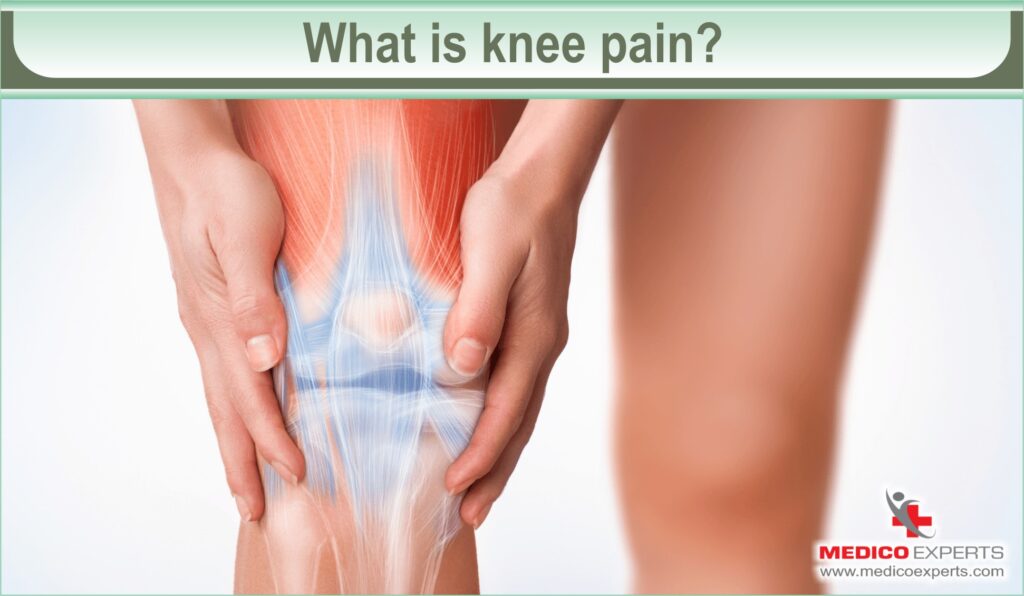
Knee pain occurs when wear and tear happen in the knee. It can happen to people of any age, most common in old age.
Commonly knee pain is the result of an injury, such as a ruptured ligament or torn cartilage. Cartilage is the flexible connective tissue on the ends of the bone.
Medical conditions such as arthritis, gout, lupus, and infections also can cause knee pain.
Physical therapy and knee braces help in relieving minor pain. In some cases, however, your knee may require surgical repair apart from surgical alternative treatment options are also available.
What are the sign and symptoms of knee pain?
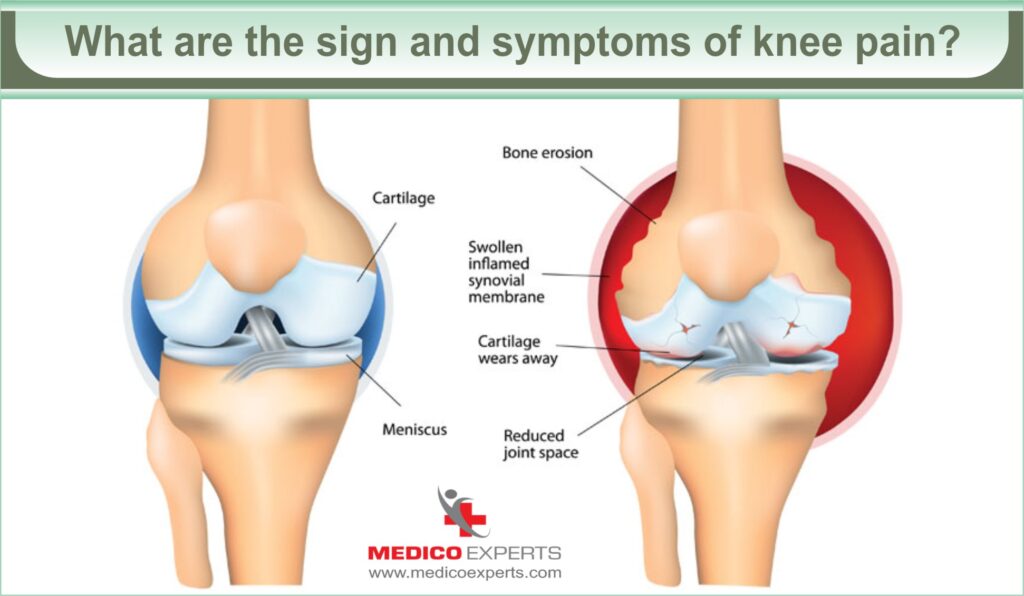
Knee Pain Varies with Location and Extent of Damage
- Infection or an inflammatory process: The whole knee might be swollen and painful.
- Torn meniscus or fracture of a bone: Gives symptoms only in one specific location of the knee.
- Baker cyst: Typically causes pain in the back of the knee.
Some of the signs and symptoms that go along with knee pain include:
- Swelling and stiffness
- Redness and warmth to the touch
- Weakness or instability
- Popping or crunching noises
- Inability to fully straighten the knee
- Unable to bend the knee
Now we have understood the signs of knee pain let’s understand some common causes.
What are the most common causes of knee pain?
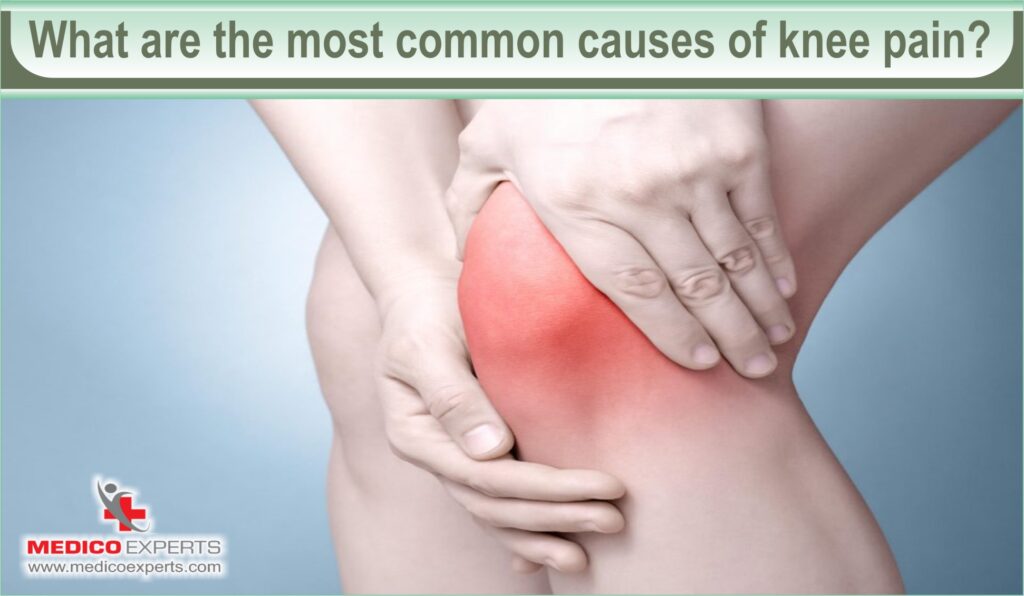
Below is a list of some of the common causes of knee pain.
a. Injuries
Injury is the common cause of knee pain. It can affect ligaments, bones, tendons (which is a soft tissue that connects muscle to the bone), and fluid-filled sacs(bursae) that surround the knee.
Knee injuries include:
ACL injury:
An ACL (anterior cruciate ligament) injury is a tear or sprain of the ACL, one of the strong bands of tissues that connect your shinbone(tibia) to your thighbone(femur).
Typically ACL injury occurs in people who play sports that require sudden changes in direction.
Fractures:
Accident is the common cause of fracture in which the bones of the knee, including the kneecap (patella), can be broken.
Osteoporosis can also cause knee fractures simply by stepping wrong because it is a disease that weakens the bone.
Torn meniscus:
The meniscus (c-shaped, tough rubbery cartilage) acts as a shock absorber between your shinbone(tibia) and thighbone(femur).
This can happen when you suddenly twist your knee while lifting a heavyweight.
Knee bursitis:
Knee injuries cause inflammation in the bursae which are small sacs of fluid that cushion the outside of your knee joint so that tendons and ligaments glide smoothly over the joint.
Patellar tendinitis:
Tendinitis causes irritation and inflammation of one or more tendons (the thick, fibrous tissues that attach muscles to bones).
This inflammation can happen when there’s an injury to the patellar tendon, which runs from the kneecap (patella) to the shinbone and allows you to kick, run and jump.
Typically sports and activities that may develop patellar tendinitis includes running and jumping.
b. Mechanical problems
Mechanical problems that cause knee pain includes:
- Loose body: Sometimes, injury or degeneration of bone or cartilage can cause a piece of bone or cartilage to break off and float in the joint space. A loose body may not create any problems unless it interferes with knee joint movement; the effect is something like a pencil caught in a door hinge.
- Iliotibial band syndrome: It’s a long piece of connective tissue that extends from outside of your leg from the hip to the knee and shinbone. Overuse and repetitive bending of the knee and extension of the knees usually cause this type of injury.
- Dislocated kneecap. This occurs when the triangular bone that covers the front of your knee (patella) slips out of place, usually to the outside of your knee. In some cases, the kneecap may stay displaced, and you’ll be able to see the dislocation.
- Hip or foot pain. If you have hip or foot pain, you may change how you walk to spare your painful joint. But this altered gait can place more stress on your knee joint and cause knee pain.
c. Types of arthritis
Some variety of arthritis most likely to affect the knee include:
Osteoarthritis:
Osteoarthritis is degenerative arthritis, osteoarthritis is the most common type of arthritis. In this condition wear-and-tear occurs when the cartilage in your knee deteriorates with use and age.
Rheumatoid arthritis:
Rheumatoid arthritis is a chronic disease, it tends to vary in severity or may even come and go. It usually weakens the joints, rheumatoid arthritis is an autoimmune condition that can affect almost any joint in your body, including your knees.
Gout:
It occurs when too many uric acid crystals build up in the joint. While gout most commonly affects the big toe, it can also occur in the knee.
Pseudogout:
Pseudogout is caused by calcium-containing crystals that develop in the joint fluid. Knees are the most common joint affected by pseudogout. These calcium deposits cause inflammation in the knee.
Septic arthritis:
Septic arthritis is an infection in knee joints, that can come through germs that can travel through your bloodstream. Leading to swelling, pain, and redness.
Septic arthritis can quickly cause extensive damage to the knee cartilage. If you have knee pain with any of the symptoms of septic arthritis, see your doctor right away.
d. Other Problems
Patellofemoral pain syndrome:
It is a condition in which cartilage under the knee cap is damage.
It’s common in athletes; in young adults, especially those whose kneecap doesn’t track properly in its groove; and in older adults, who usually develop the condition as a result of arthritis of the kneecap.
Knee pain diagnosis and tests
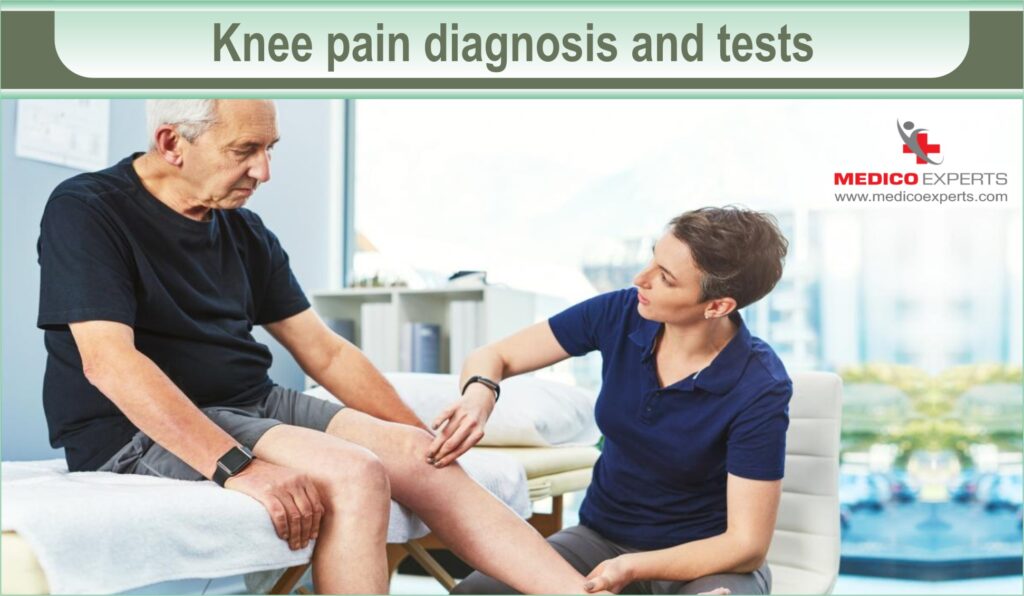
Physical examination:
- The doctor will Inspect your knee for swelling, pain, sensitivity to pain, warmth, and visible bruising
- The doctor will check your knee movement
- Evaluate the integrity of the structures in your knee
Imaging tests:
In some of the imaging tests were:
- X-ray: X-ray, will help to detect bone fractures and degenerative joint disease.
- Computerized tomography (CT) scan: CT scans can help diagnose bone problems and subtle fractures. A special kind of CT scan can accurately identify gout even when the joint is not inflamed.
- Ultrasound: This technology uses sound waves to produce real-time images of the soft tissue structures within and around your knee. Your doctor may want to move your knee into different positions during the ultrasound to check for specific problems.
- Magnetic resonance imaging (MRI): An MRI is particularly done to identify injuries of the soft tissues such as ligaments, tendons, cartilage, and muscles.
Now let’s understand treatment options for knee pain.
Conventional treatment for knee pain and cartilage regeneration in India
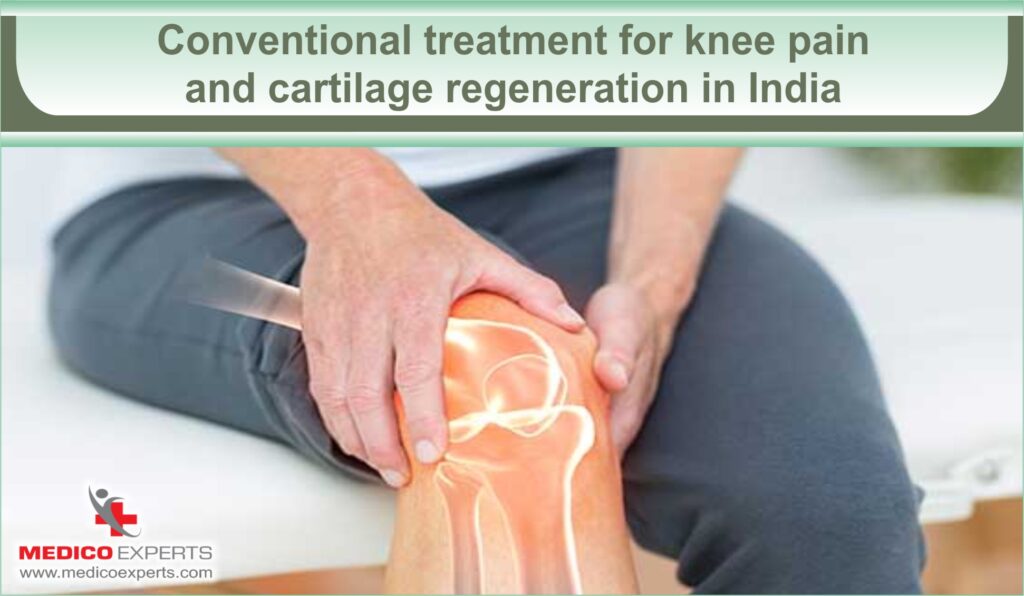
Treatments will vary, depending upon the severity and causes.
Medications
Medications to help relieve pain and to treat the conditions causing your knee pain, such as rheumatoid arthritis or gout.
Therapy
Physical therapy or different types of strengthening exercises based on the specific condition that is causing your pain is done to strengthening the muscles around your knee will make it more stable.
Injections
- Corticosteroids: Injections of a corticosteroid drug into your knee joint may help reduce the symptoms of an arthritis flare and provide pain relief that may last a few months. These injections aren’t effective in all cases.
- Hyaluronic acid: A thick fluid, similar to the fluid that naturally lubricates joints, hyaluronic acid can be injected into your knee to improve mobility and ease the pain.
- Platelet-rich plasma (PRP): PRP contains a concentration of many different growth factors that appear to reduce inflammation and promote healing. Some studies have found that PRP may benefit certain people with osteoarthritis, but more studies are needed.
Surgery
If you have an injury that may require surgery, it’s usually not necessary to have the operation immediately. Before making a decision, consider the pros and cons of both nonsurgical rehabilitation and surgical reconstruction in relation to what’s most important to you.
If you choose to have surgery, your options may include:
Arthroscopic surgery:
Depending on your injury, your doctor may be able to examine and repair your joint damage using a fiber-optic camera and long, narrow tools inserted through just a few small incisions around your knee.
Arthroscopy may be used to remove loose bodies from your knee joint, remove or repair damaged cartilage (especially if it is causing your knee to lock), and reconstruct torn ligaments.
Partial knee replacement surgery:
In this procedure, your surgeon replaces only the most damaged portion of your knee with parts made of metal and plastic.
The surgery can usually be performed through small incisions, so you’re likely to heal more quickly than you are with surgery to replace your entire knee.
Total knee replacement:
In this procedure, your surgeon cuts away damaged bone and cartilage from your thighbone, shinbone, and kneecap, and replaces it with an artificial joint made of metal alloys, high-grade plastics, and polymers.
Osteotomy:
This procedure involves removing bone from the thighbone or shinbone to better align the knee and relieve arthritis pain. This surgery may help you delay or avoid total knee replacement surgery.
Now let’s explore the possibility of knee pain relief without surgery with advanced treatment option below.
Advanced treatment for knee pain relief without surgery in India
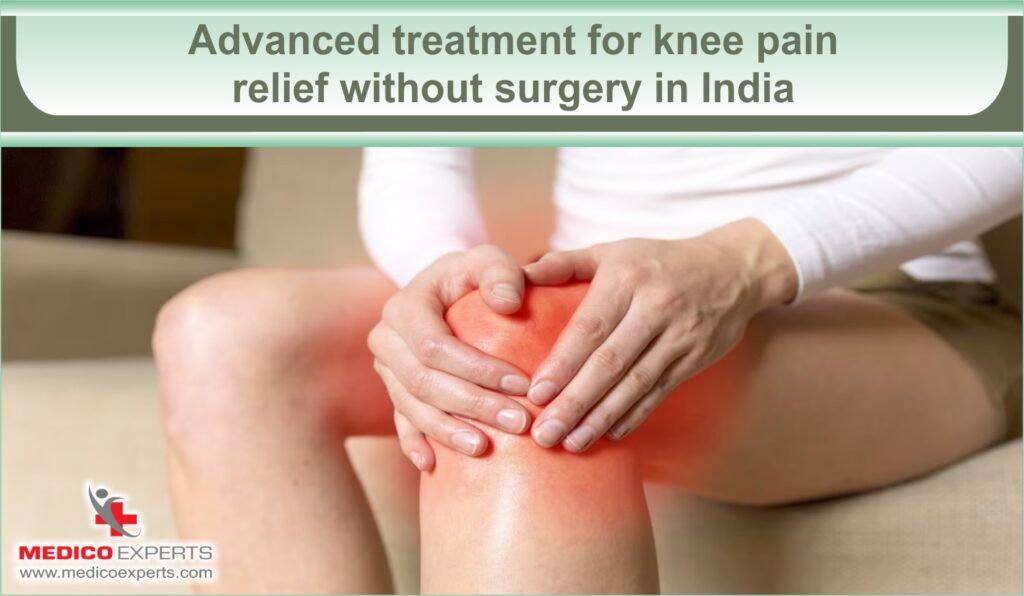
Stem cell therapy for knee pain relief:
When the knee joint is damaged, some of the cartilage that cushions the bones is lost. This causes pain and swelling in the joint.
Stem cells are special cells that can change into different types of cells. In the knee, they can turn into cartilage cells and help to make more of them.
They can also release substances that help the existing cartilage to heal and grow. This way, stem cell injections for knees can restore some of the lost cartilage and improve the function of the joint.
For more information on how stem cell therapy works for knee cartilage regeneration please visit:



